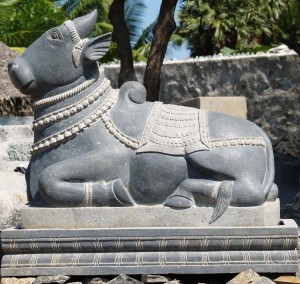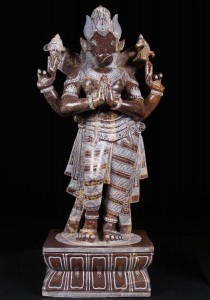
Within Hinduism, Nandi, or sometimes called Nandin, takes on many different roles. In his most prevalent form he is the sacred steed of Shiva the Hindu god of Destruction, depicted as a powerful white bull. His white color is marked as a symbol of purity and devotion. Nandi is said to be Shiva’s main form of transportation and most ardent devotee. As his most astute follower, Nandi is in charge of leading all of Shiva’s followers. Along the same lines, Nandi is regarded as the gatekeeper and protector of Shiva as well as Shiva’s consort the Hindu Goddess Parvati. He can be found in many temples dedicated to Shiva throughout Asia seated and facing the main temple as protector. His name, Nandi, is even used as metaphor meaning “to stand in the way of”. It is said that one must first gain the approval of Nandi before being allowed worship of Lord Shiva himself.

As a primary Hindu God, Nandi is traced in lineage back to ancient dairy farmers that depended on cows for their main livelihood. As their foremost source of sustenance, Nandi was worshiped as keeper of the herds. In this form he was said to be bull-faced with a body much like his hallowed Shiva, but with 4 hands. Two hands holding axe and antelope, and the other two joined in homage. In this human form he is known as Nandikeshwara.
It is said that many women visit these large Nandi statues outside temples throughout the world and decorate him with flowers and touch his stone in order gain fertility. Many worshipers who flock to his side also often whisper to in him in order to announce their hopes and dreams hoping Nandi relays their message on to Shiva.
Click here to read more about Shiva the Destroyer
